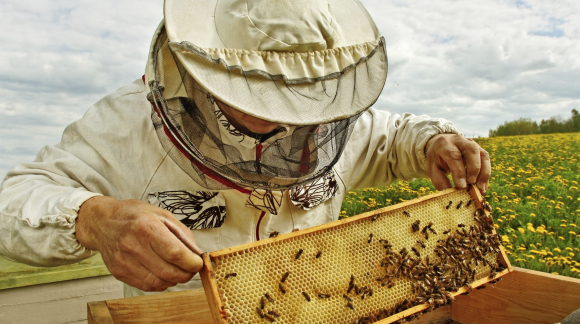The Basics of Beekeeping

The Benefits of Bees
Gardening is one of the most popular hobbies in America. The hobby of beekeeping is growing at a slow but steady rate, and is closely related to gardening. Many crops rely on bee pollination to successfully flourish, which makes beekeeping worthwhile to those who grow their own food or maintain a flower garden. Without bee pollination, we would lose some of our most delicious fruit and veggies, including:
- Apples
- Almonds
- Blueberries
- Cherries
- Avocadoes
- Cucumbers
- Onions
- Grapefruit
- Melons
- Oranges
- Pumpkins
- Strawberries
- Squash
Perhaps the main tangible benefit of beekeeping is honey – lots of honey. A single, healthy hive can yield 50 to 100 pounds of it.
Honey is much like a magic potion in the food industry and is known to offer a plethora of health benefits including, clearing your sinuses, and relieving symptoms of the common cold, reducing the craving for cigarettes, healing oral ulcers and relieving abdominal pain.
Points of Consideration
In the simplest of terms, to start beekeeping you need two things: (1) hive equipment (2) bees. However, before you jump in and begin your new hobby, you should consider a few important facts:
- Local nuisance laws may not allow beekeeping in your town.
- While you know beekeeping is great for the neighborhood, your neighbors might think differently, especially those with pets and young children.
- The hobby requires time, physical strength, and money.
- You will get stung occasionally, there is no way to avoid it.
Once you’ve addressed these issues, you can take the first steps to building your hive.
How to Get Started
Beehives come in a variety of shapes and sizes. Like most things in life, you can start small, with a little hive, and work your way up to a larger one.
The easiest way to start beekeeping is by purchasing a hive starter kit. The kits range in price from $200 to $600 and vary in size. The basic starter kit includes:
- Hive body – the main structure for your hive, often already assembled and painted
- Frames – the structural element that holds the hive body together.
- Pitch helmet and mesh veil– worn for facial protection
- Hive tool – similar to a flat head screwdriver you can use this tool to loosen hive bodies and frames
- Smoker – a tool used to calm the bees by mixing various chemicals into smoke
It is important that your materials are new, as old equipment can breed disease and make successful beekeeping nearly impossible.
After you secure the proper equipment, you need to purchase your bees. When determining who to buy your insects from, you should consider referrals from friends and always buy from an established supplier who is experienced in shipping live insects.
Check out your local community college for beekeeping classes. These classes can serve as a great resource for local experts.
To support your community and avoid shipping costs, you can purchase bees locally.
The bees will be sent in a nucleus hive (nuc), which acts as a home for the full colony of bees. The nuc is made up of frames, which is a critical component of your starter kit, and come in either plastic or wood form.
The following are established suppliers of bees and bee equipment:
Whether you want to aid your garden or find a challenging new hobby, beekeeping has much to offer those who are not afraid to get stung.
Additional Resources
- History of Beekeeping in the United States, by Everett Oertel
- Beekeeping as a Hobby, by ibuzzle.com
- Backyard Beekeeping, by outdoorplace.org
- How to Start Beekeeping, by bestbeekeeping.com
- Beekeeping 101: Why Raise Honeybees, by Heather Brown
- Beekeeping 101: Getting Started Part 1, by Heather Brown
- Beekeeping 101: Getting Started Part 2, Equipment, by Heather Brown
- Beekeeping: A Hobby with Sweet Rewards, by Suzanne DeJohn
- Beekeeping Equipment Essentials, by bestbeekeeping.com
- Beekeeping Supplies, by dadant.com
Videos
- Beekeeping, by ncfarmbureau
- Silence of the Bees, by sciencekids.co.nz
- Extracting Honey, by honeybeesonline.com
- Flight of the Honey Bee, by pbs.org
- Bees and Beekeeping on a Hobby Farm, by Spring Chicken Media
- The Honeybee and the Hexagon, by ed.ted.com
Education
- Bee Education, by savannahbee.com
- Bee-ginner’s Beekeeping, by cpe.rutgers.edu
Books
- Backyard Beekeeper, by Kim Flottum
- The Beekeeper’s Bible, by Richard Jones and Sharon Sweeney-Lynch
- Beekeeping for Dummies, by Howland Blackiston and Ed Weiss
- Build Your Own Beekeeping Equipment, by Tony Pisano
Apps
- Beekeeping, by gap Web Agency Limited, available on iTunes for a fee
- Organically Managed Beekeeping Podcast, by C. Yerdon, available on iTunes for free
